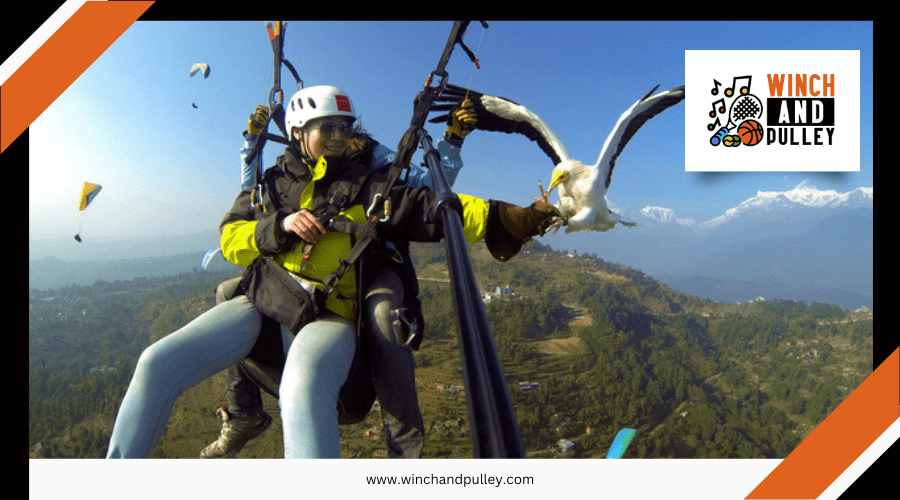Parahawking: Combining Paragliding With Falconry

Imagine the thrill of soaring through the skies, guided by a majestic bird of prey. Parahawking, a unique fusion of paragliding and falconry, offers just that. Originating in Nepal, this adventure pairs you with trained raptors such as Egyptian vultures and Harris's hawks, who assist you in finding thermal currents for an optimal flight.
You might wonder how such a symbiotic relationship between human and bird is cultivated and maintained. Let's explore the intricacies of this fascinating activity, from its origins and training processes to the conservation efforts that make it sustainable.
Key Takeaways
Parahawking, an activity that merges paragliding with falconry, allows trained birds to guide paragliders to thermals. Initiated by Scott Mason in Nepal in the early 2000s, it rapidly gained global recognition. Utilizing birds such as Egyptian vultures and Harris's hawks, trained via falconry techniques, the experience promotes bird conservation and eco-friendly tourism. Renowned parahawking locations include Nepal, Spain, and the United States, drawing adventurers from around the globe.
Origins of Parahawking
In the early 2000s, British falconer Scott Mason pioneered parahawking in Nepal, blending paragliding with falconry to create a unique adventure. Mason, driven by his passion for birds of prey and the exhilaration of flight, envisioned a way to combine these interests. He saw an opportunity to not only witness the beauty of these birds up close but also educate others about their behavior and conservation needs.
Parahawking provides a distinctive perspective on birds of prey in flight, offering insights that traditional birdwatching or falconry alone cannot. By training captive birds to guide paragliders through the skies, Mason created an interactive and educational experience. This innovative concept quickly gained traction, attracting adventurers and bird enthusiasts alike.
The success of parahawking in Nepal soon led to its expansion into other countries, including Spain and the United States. This growth enabled more people to experience the thrill of parahawking while fostering a deeper appreciation for birds of prey and their natural behaviors.
How Parahawking Works
View this post on Instagram
While parahawking, you'll encounter remarkable raptors such as Egyptian vultures, black kites, and Harris's hawks. These birds aren't only captivating to observe but are also trained using specific techniques involving meat morsels and falconry methods. Understanding the types of raptors and their training enhances your appreciation for this unique fusion of sport and wildlife interaction. When engaging in parahawking, you'll be guided by trained raptors such as Egyptian vultures, black kites, and Harris's hawks. These birds are selected for their exceptional soaring abilities and intelligence, making them ideal companions for this fusion of paragliding and falconry. Each species brings unique traits that enhance the parahawking experience. Egyptian vultures are renowned for their excellent gliding skills and sharp eyesight, which enable them to identify thermal updrafts that paragliders can exploit to remain airborne. Black kites are noted for their agile flight patterns and adaptability, allowing them to navigate various wind conditions effectively. Harris's hawks are highly social and trainable, making them dependable partners in the sky. These raptors are typically sourced from specialized facilities like the Himalayan Raptor Rescue center, ensuring they receive proper care and expert training. Scott Mason, the innovator behind parahawking, works with a dedicated team to prepare these birds for their unique role. Parahawking has grown beyond Nepal to include countries such as Spain and the United States, demonstrating the versatility and appeal of different raptors in this exhilarating activity. Training birds for parahawking involves a blend of traditional falconry and positive reinforcement with meat morsels. Birds such as Egyptian vultures, black kites, and Harris's hawks excel in this activity. These birds are often sourced from the Himalayan Raptor Rescue facility in Nepal and trained to follow paragliders. Experienced handlers, part of Scott Mason's dedicated five-member team, use specific methodologies. Initially, they acclimatize the birds to human interaction and paragliding equipment. Positive reinforcement is then employed; birds that follow gliders correctly are rewarded with meat morsels, associating paragliding with a positive experience. Training is frequent and consistent, ensuring the birds are comfortable and responsive in various flight conditions. This meticulous process is crucial for the safety and enjoyment of both birds and paragliders. The success of this training has enabled parahawking to expand beyond Nepal to countries like Spain and the United States. This global reach demonstrates the effectiveness of these bird training techniques, making the unique activity accessible to more adventure enthusiasts. In parahawking, specialized trainers use meat morsels and falconry techniques to teach birds, such as Egyptian vultures and black kites, to soar alongside paragliders. These birds come from the Himalayan Raptor Rescue facility, ensuring they receive proper care before training begins. The training process is designed to build a strong bond between the birds and their trainers, which is crucial for successful parahawking flights. This process includes several key steps: Scott Mason's team, consisting of five dedicated members, meticulously trains each bird, capturing global interest and leading to parahawking operations in countries like Spain and the United States. This unique combination of nature and adventure offers an unparalleled experience. When you participate in parahawking, you experience the exhilarating sensation of soaring through the sky with a trained bird of prey right by your side. This adventure isn't only thrilling but also deeply enriching for nature lovers. The sight of a majestic raptor gliding effortlessly alongside you offers a unique perspective on these magnificent creatures' behavior and flight patterns. Participants often describe their parahawking experience as awe-inspiring and unforgettable. You'll develop a profound appreciation for the beauty and skills of trained falcons, and the connection you foster with these birds is truly special. Here are some highlights of what you can expect: Nature lovers will cherish this extraordinary adventure, which combines the thrill of paragliding with the elegance of falconry. To begin your parahawking experience, contact Total Raptor eXperience to schedule a session at one of their beautiful locations, such as Torrey Pines Gliderport or Ramona, CA. You can reach them via email at info@totalraptorexperience.com or by phone at (619) 535-7307. The booking process is simple, ensuring you're prepared for an unforgettable adventure. For the best experience, visit their website to explore parahawking opportunities, book a session, and learn about their services. By subscribing to Total Raptor eXperience, you'll receive updates on future parahawking adventures and a congratulatory message upon successful subscription. Here's a quick guide to help you with the booking process: Staying connected with the parahawking community is easy. Follow Total Raptor eXperience on social media to engage with other enthusiasts and share your experiences. Securing your parahawking session ensures you're part of a community that blends adventure with the beauty of nature. The controversy with falconry centers on animal welfare and ethical practices. Concerns include potential cruelty and the illegal possession of endangered birds, which has sparked significant debate within the falconry community. Falconry is illegal in Australia to protect native bird species and wildlife populations. This regulation is enforced under the Environment Protection and Biodiversity Conservation Act 1999 to maintain the country's unique ecological balance. A person who practices falconry is called a falconer. Falconers train and hunt with birds of prey like falcons and hawks, developing a close bond through extensive training, handling, and flying. Yes, falconers can make money through various avenues such as demonstrations, educational programs, pest control, hunting expeditions, bird training, and selling specialized equipment. The income potential depends on the falconer's expertise, reputation, and the demand for their services. Experience an adventure like no other with Parahawking! Soar through the skies alongside trained birds of prey, forging an unforgettable connection with nature. Guided by majestic raptors, you'll feel the exhilaration of paragliding while supporting bird conservation efforts. Book your parahawking adventure now and create lifelong memories. Embrace the thrill and majesty of parahawking today!Activity Description Benefit Pre-flight Brief Introduction to the bird and safety instructions Ensures a safe and informed experience Take-off Launch with the bird flying nearby Establishes an immediate bond In-flight Follow the bird to find thermals Optimizes flight and demonstrates falconry Landing Return to the ground with the bird Ends with a sense of achievement The Birds Involved
Types of Raptors Used
Bird Training Techniques
Training Process
Safety Measures
Safety Measure Description Purpose Certified Pilots Trained in paragliding and falconry Ensure overall safety and control Specialized Equipment Custom harnesses, safety lines Enhance flight safety Pre-Flight Safety Briefings Instructions on protocols and emergency measures Prepare participants Conservation Efforts
Protecting Endangered Bird Species
Sustainable Tourism Practices
Educating the Public
Popular Destinations
Participant Experiences
Booking Your Adventure
Step Action 1 Visit the Total Raptor eXperience website. 2 Select your preferred location. 3 Choose a suitable date and time. 4 Complete the booking form or contact them directly. Frequently Asked Questions
What Is the Controversy With Falconry?
Why Is Falconry Illegal in Australia?
What Do You Call Someone Who Does Falconry?
Do Falconers Make Money?
Conclusion




